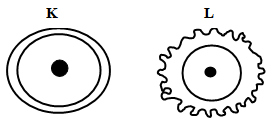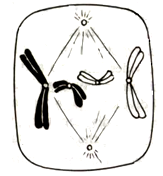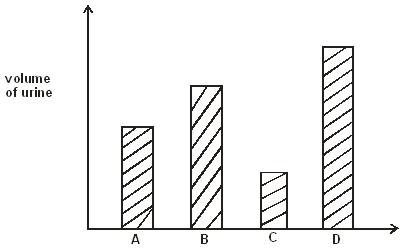Instructions to Candidates:
- Answer all questions
- Candidates should answer the questions in English.
- Grazers and browsers co-exist without problems with each other. Explain. (2marks)
- With reference to the leaves only give two adaptations of submerged hydrophytes. ( 2marks)
-
-
- Name the part of the eye where image is formed. (1mark)
- State two characteristics of the image formed on part named in (a) above. (2marks)
- State the functional difference between semi circular canals and the vestibule apparatus of the ear. ( 2marks)
-
- A layer of glycerine was applied on upper surface of a freshwater floating plant that had been kept in the dark for 24 hours. The plant was left undisturbed in bright light. After three hours test for starch carried out on the leaves produced a brown colour of iodine solution. Account for the observation. (3 marks)
- A form four student was walking around the school compound and saw leaves from Nandi flame tree on the ground.
- Name the hormone responsible for this phenomenon. (1 mark)
- State the significance of the above phenomenon to the tree. (2 marks)
- The following are diagrams of two pollen grains.
- State one observable difference between K and L. (1 mark)
- State the agent of pollination for each of them. (2 marks)
- During oxidation of certain food substances, the respiratory quotient was found to be 0.718.
- Name the type of food substance being oxidized. (1mark)
- State two advantages of using the food substances named. (2marks)
- The diagram below represents a cell at one stage of the cell division.
- Identify the stage. (1 mark)
- Is the cell of a plant or an animal? (1 mark)
- Give a reason for your answer in (b)(ii) above. (1 mark)
- Identify the stage. (1 mark)
- The quantity of urine passed per day was measured in four mammals; A, B, C and D of the same species in their natural habitats. The results were as shown below.
In what form is nitrogenous waste likely to be in organism D? Explain. (3 marks) - Explain why it is advisable to breathe through the nose rather than the mouth in man. (2 marks)
- Name the valve which opens during:
- Systole ………………………………………………………………...................(1 mark)
- Diastole…………………………...............……………………………………… (1 mark)
- State the branch of Biology that would be used in solving the problem of disputed parentage. (1mark)
- Explain why carbohydrates are stored in their polysaccharide forms in both plants and animals. (3 marks)
- Name the organelles that are abundant in:
- Goblet cells ..........................................................................................................(1 mark)
- Liver cells..............................................................................................................(1 mark)
- Give a reason why it is difficult to calculate Respiratory Quotient (RQ) in plants. (2 marks)
- A biological washing detergent contains enzymes which remove stains like mucus and oils from clothes which are soaked in water with the detergent.
- Name the two groups of enzymes that are present in the detergent. (2 marks)
- Why would the stains be removed faster with the detergent in water at 35°C rather than at 15°C? (2 marks)
- Explain why it is important to go for Voluntary Counselling and Testing (VCT) on HIV/AIDS. (2 marks)
- The diagram below shows the eggs of a certain amphibian.
- State three functions of the jelly. (3 marks)
- What is the biological importance of the organism laying many eggs? (1 mark)
- The diagram below show various types of gene mutations.
Mutation I
Mutation II- Identify the type of mutations shown above (2 marks)
- Name one disorder that results from gene mutation II. (1 mark)
- State three advantages of metamorphosis to the life of an insect (3marks)
-
- State two limitations of fossil records as an evidence for organic evolution theory. (2marks)
- State an idea that led to the formulation of Lamarck’s theory of evolution. (1mark)
- Explain what happens to red blood cells placed in distilled water for 20 minutes. (3 marks)
- Below is a photograph of an organism

- Identify the class to which this organism belongs to. (1 mark)
- Give reasons for your answer in (i) above. (2 marks)
- What are the functions of the odontoid process found on the axis bone of the vertebra (2marks)
- Give three main reasons why plants do not require an elaborate excretory system like animals (3marks)
- Study the diagram of an animal below and answer the questions that follow.
- Name the part labeled P (1mark)
- How is the above structure adapted to its function? (2marks)
- State how herbaceous plants obtain their support (3marks)
-
- Name two structures for gaseous exchange in aquatic plants. (2 marks)
- Explain why guards cells have thicker inner walls and thinner outer walls. (1 mark)
- Explain the significance of etiolation in plants growing in the dark (2 marks)

MARKING SCHEME
-
- They occupy different ecological niches; grazers feed on grass while browsers feed on herbs ,shrubs, and twigs hence no competition; OWTTE;
-
- Submerged parts have large air spaces to provide buoyancy;
- Broad leaves with numerous stomata on upper surface to increase surface area for water loss and gaseous exchange;
- Some submerged hydrophytes have leaves which are deeply dissected into threadlike straws in order to provide large surface areas for trapping of maximum light for photosynthesis;
- Submerged hydrophytes have highly photosensitive Chloroplasts that can photosynthesise at low light intensities;
-
-
- Retina;
-
- Image is inverted;
- Image is smaller than the real object;
- The image is real;
- Semi-circular canals maintain body balance and posture with respect to movement of the heat while vestibules apparatus maintain body balance and posture with respect to gravity; (Tied- both must be correct to score)
-
- The leaf had stomata only on the upper surface; which were blocked by glycerine cutting supply of carbon(IV) oxide; no photosynthesis takes place hence absence of starch;
-
- Absciscic acid;
- Reduce (the rate of) transpiration;
-
- K is smooth while L is rough;
- K – wind; L – Insect;
-
- Fats /lipids;acc oils
- Release large amounts for energy per molecule on oxidation; produces a lot of water on oxidation; (use of other metabolic activities)
-
- Metaphase;
-
- Animal;
- Presence of centrioles;
- Ammonia; requires a lot of water to be diluted for elimination; since it is very toxic;
-
- Air is warmed;
- Air is moistened;
- Smell in the air is detected;
-
- Atrio – ventricular valves/ cuspid valves/tri and bicuspid valves;
- Semi – lunar valves
- Genetics;
- Are insoluble in water; and hence are osmotically inactive; and therefore cannot affect the osmotic pressure of the surrounding / storage cells;
-
- Golgi bodies / Golgi apparatus
- Mitochondria
- Carbon (IV) oxide produced in respiration is utilized in photosynthesis; oxygen produced in photosynthesis is used in respiration ;
-
- Protease; Lipase;
- 35°C is the optimum temperature for the enzyme to act; at 15°C enzymes are inactivated since the temperature is low;
- To know HIV status; so as to take appropriate measures; if positive start medication /negative avoid infection;
-
-
- Prevents eggs from drying up/regulate temperature;
- Contain substances repellant to predators
- Hold eggs together in vegetation/keeps eggs afloat;
- Serve as food for tadpoles immediately after hatching; (any 3)
-
- Increases chances of fertilization/survival;
- Compensate for eggs swept away by water /
- Eaten by predators/dehydrated;
-
-
-
- Deletion
- Substitution
- Albinism/Sickle - cell anemia;
-
-
- Adult and larva exploit different food niches;
- They do not compete for food;
- Pupa can survive adverse conditions;
- It prevents overcrowding;
-
-
- Destruction of fossils by geological activities;
- Distortion of information due to sedimentation;
- Missing record/links; only first two
-
- the theory of need;
- the theory of use and disuse
- acquired traits can be inherited;
-
- Red blood cells draw in water by osmosis; They swell/enlarge and the cell membrane Bursts ( by a process called haemolysis)
-
- Crustacea; must begin with capital letter-(1 mark)
-
- Two pairs of antennae;
- Presence of carapace;
-
- Fits in the neural canal of the atlas
- Allows rotational movement of the head
-
- There is little accumulation of toxic waste in plants;
- Plants reuse some of their excretory waste products; e.g. CO2 & O2
- Some of the excretory waste products are converted to less toxic substances which are then stored in some plant parts
- Waste formed is from carbohydrate metabolism and are not poisonous; (First 3, 3mks)
-
- P - Capitulum;
-
- Has tuberculum which articulates with tuberculum on transverse process;
- Has capitulum which articulates with capitular demifacets on centrum of transverse process;
- Curved anteriorly to form thoracic cage; any two.
-
- Turgidity or firmness obtained through absorption of water by osmosis
- Twining stems-stems coil around hard object
- Tendrils –modified leaves which curl around other plants
-
-
- Stomata;
- Aerenchya;
- Pneumatophores;
- Epidermis;
- Cuticle;
- Guard cells regulate the opening and closing of stomata, when they are turgid they bulge out and the thicker inner walls have a gap between them therefore opening the stomata;
-
- Plant stem grow faster over obstacles to reach the light; before the stored food is used up and develop chlorophyll;
Join our whatsapp group for latest updates
Tap Here to Download for 50/-
Get on WhatsApp for 50/-
Download Biology Paper 1 Questions and Answers - Lanjet Mock Exams 2021/2022.
Tap Here to Download for 50/-
Get on WhatsApp for 50/-
Why download?
- ✔ To read offline at any time.
- ✔ To Print at your convenience
- ✔ Share Easily with Friends / Students





